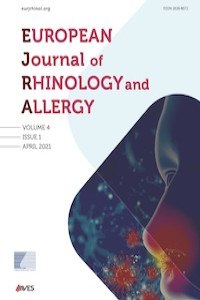The Effects of the Combined Use of Merocel and Silicone Nasal Packs on Pain, Bleeding, and Mucociliary Activity After Septoplasty
Abstract
Objective: Epistaxis is one of the common complications after septoplasty. The type of packs more effective in preventing bleeding after the surgery is still a matter of debate. The aim of this study is to compare the effects of airway Doyle Silicone pack, Merocel pack, and the combination of Merocel and silicone packs on pain, bleeding, and mucociliary clearance after septoplasty.
Material and Methods: This study is a prospective cohort study. A total of 75 patients who underwent septoplasty were divided into 3 groups: silicone pack was applied to the first group (termed group S), Merocel pack was applied to the second group (termed group M), and a combination of Merocel and silicone packs was applied to the third group (termed group M+S). The amount of bleeding, the intensity of pain, and mucociliary clearance duration were compared.
Results: The amount of bleeding in group M+Swas significantly lower than that in group S (p<.001). The amount of bleeding in group M+Swas significantly lower than that in group M (P=.003). Pain was significantly lower in group S than in groups M and M+S (p<.001 and p=.024).
Conclusion: It was determined that combined use of silicone and Merocel packs after septoplasty caused less bleeding than the useof silicone pack or Merocel pack alone. The combined use of Merocel and silicone packs can be a good alternative packing method because it reduces nasal bleeding after septoplasty.
References
- Stewart MG, Witsell DL, Smith TL, Weaver EM, Yueh B, Hannley MT. Development and valida-tion of the Nasal Obstruction Symptom Evaluation (NOSE) scale. Otolaryngol Head Neck Surg 2004; 130: 157-63.
- Ertugay ÇK, Külekçi S, Naiboglu B, Ertugay ÖÇ, Sengül E, Kaya KS. Effect of nasal packs on nasal obstruction and complications of septoplasty. J Med Updates 2014; 4: 56-60.
- Hwang JH, Liu CM, Liu TC, Hsu MC. Sphenopalatine ganglion block before removal of nasal packing. Laryngoscope. 2003; 113: 1423-4.
- Genç E, Ergin NT, Bilezikçi B. Comparison of suture and nasal packing in rabbit noses. Laryngo-scope 2004; 114: 639-45.
- Acıoğlu E, Edizer DT, Yiğit Ö, Onur F, Alkan Z. Nasal septal packing: Which one? Eur Arch Oto-rhinolaryngol 2012; 269: 1777-81.
- Ardehali M, Bastaninejad S. Use of nasal packs and intranasal septal splints following septo-plasty. Int J Oral Maxillofac Surg 2009; 38: 1022-24.
- Weber R, Keerl R, Hochapfel F, Draf W, Toffel PH. Packing in endonasal surgery. Am J Oto-laryngol 2001; 22: 306-20.
- Alkan Z, Yiğit O, Acıoğlu E, Server EA, Uzun H, Civelek S. The effect of nasal packing on oxida-tive stress in septoplasty operation. Turk Arch Otolaryngol 2013; 251: 20-2.
- Deitmer T. Physiology and pathology of the mucociliary system. Special regards to mucocili-ary transport in malignant lesions of the human larynx. Adv Otorhinolaryngol 1989; 43: 105-36.
- Lale A, Mason J, Jones N. Mucociliary transport and its assessment: A review. Clin Otolaryngol 1998; 23: 388-96.
- Alberty J, Stoll W. The effect of antiallergic intranasal formulations on ciliary beat frequency of human nasal epithelium in vitro. Allergy 1998; 53: 986-9.
- Uslu H, Uslu C, Varoglu E, Demirci M, Seven B. Effects of septoplasty and septal deviation on nasal mucociliary clearance. Int J ClinPract 2004; 58: 1108-11.
- Ginzel A, Illum P. Nasal mucoliliary clearance in patients with septal deviation. Rhinology 1980; 18: 177-81.
- Jang YJ, Myong NH, Park KH, Koo TW, Kim HG. Mucociliary transport and histologic charac-teristics of the mucosa of deviated nasal septum. Arch Otolaryngol Head Neck Surg 2002; 128: 421-4.
- Çukurova I, Yalçin Y, Kirsen H. Comparison of postoperative mucociliary clearance times in patients who had undergone septoplasty with or without tampon application. J Med Updates 2012; 2: 15-8.
- Chevillard C, Rugina M, Bonfils P, et al. Evaluation of calcium alginate nasal packing (Algosté-ril®) versus polyvinyl acetal (Merocel®) for nasal packing after inferior turbinate resection. Rhinology 2006; 44: 58-61.
- Bresnihan M, Mehigan B, Curran A. An evaluation of Meroceland Series 5000 nasalpacks in patients following nasal surgery: A prospective randomised trial. Clin Otolaryngol 2007; 32: 352-5.
- Garth R, Brightwell A. A comparison of packing materials used in nasal surgery. J Laryngol Otol 1994; 108: 564-6.
- Özkırış M. Comparison of the use of merocel and ınternal nasal splınt tampons after septo-plasty. ACU SağlıkBilDerg 2011: 199-202.
- Kim YS, Kim YH, Kim NH, Kim SH, Kim KR, Kim K-S. A prospective, randomized, single-blinded controlled trial on biodegradable synthetic polyurethane foam as a packing material after sep-toplasty. Am J Rhinol Allergy 2011; 25: 77-9.
- Bingöl F, Budak A, Şimşek E, Kılıç K, Bingöl BÖ. Comparison of early-period results of nasal splint and merocel nasal packs in septoplasty. Turk Arch Otorhinolaryngol 2017; 55: 136-9.
- Wadhera R, Zafar N, Gulati SP, Kalra V, Ghai A. Comparative study of intranasal septal splints and nasal packs in patients undergoing nasal septal surgery. Ear Nose Throat J 2014; 93: 396-408.
Details
| Primary Language | English |
|---|---|
| Subjects | Otorhinolaryngology |
| Journal Section | Original Article |
| Authors | |
| Publication Date | April 1, 2021 |
| Published in Issue | Year 2021 Volume: 4 Issue: 1 |
Cite
You can find the current version of the Instructions to Authors at: https://www.eurjrhinol.org/en/instructions-to-authors-104
Starting on 2020, all content published in the journal is licensed under the Creative Commons Attribution-NonCommercial (CC BY-NC) 4.0 International
License which allows third parties to use the content for non-commercial purposes as long as they give credit to the original work. This license
allows for the content to be shared and adapted for non-commercial purposes, promoting the dissemination and use of the research published in
the journal.
The content published before 2020 was licensed under a traditional copyright, but the archive is still available for free access.

